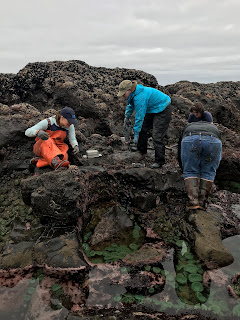Monday, June 4th
After a long week of data collection and scientific work out in the intertidal and in laboratory, the marine biology students began analyzing their data, writing their research papers, and working on their presentations. On Monday, we met with Rebecca to talk about statistical analysis and our progress.
Tuesday, June 5th - Thursday, June 7th
This week, students lived in the Guin library as they worked tirelessly on their papers and presentations. Kris and Caroline maintained a positive attitude as they compared species abundance and diversity between the eel grasses Zostera marina and Zostera japonica.
Sydney and Milan looked at the relationship between abnormally warm years and the size and abundance of chaetognath worms here on the Oregon coast.
 Alexa finishing up her and Erica's presentation on zooplankton diversity. They basically became nocturnal during their nighttime data collection last week, so seeing them work during the day was impressive and inspiring.
Alexa finishing up her and Erica's presentation on zooplankton diversity. They basically became nocturnal during their nighttime data collection last week, so seeing them work during the day was impressive and inspiring.
Friday, June 8th
Today's the day! Marine biology students made the final touches to their presentations and prepared for their final task of the course. Friends, family, and local scientists gathered in the Hatfield Marine Science Center auditorium to watch the BI 450 students present their independent research. From studying how female pheromones affect aggressive behaviors of male Dungeness crabs to observing bleaching effects of coralline algae, our class had an array of creative ideas and students worked diligently on their projects for over two weeks.
 |
| Nikki and Andy presenting their research on the distribution patterns of Hemigrapsus spp. |
 |
Simone presenting her research on the feeding preferences
of Hermissenda crassicornis.
|
This term at Hatfield was filled with memories and valuable experiences. The BI 450 students not only had a ton of fun, but also learned a lot about marine biology and what it's like to be real scientists. While trekking through the mud and getting up at 4:00 AM for intertidal work proved to be challenging at times, it was all worth the fun we had and everything our wonderful instructors taught us. Sally introduced us to the course and showed us how awesome marine biology is. With Su, we learned all about fishes and got our hands dirty with seine netting and beam trawling. Sarah showed us that algae are actually really cool and diverse. Finally, Bruce proved that at his age, you can conquer the rocky intertidal and be in way better shape than an entire group of twenty-somethings.
The BI 450 students worked hard all term and proved to be incredibly passionate ocean-lovers and future scientists. We will never forget all that we've learned and accomplished through this course, and we thank all of our professors and TA's for helping us prepare for the real world as marine biologists. We'll miss you, Hatfield!



















